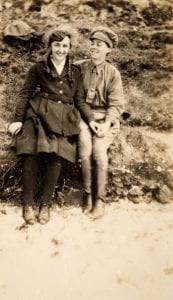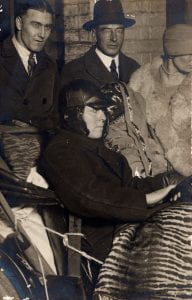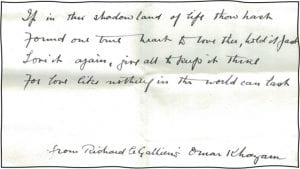With the eyes of a stranger: Alice Anderson

Alice was born in 1897. Her father was an engineer and academic. When he lost money in business the family moved to the country where Alice and her siblings learned to ride, hunt, fish and generally be self-reliant. Their lack of funds meant that she could not attend university, even though the family moved in university academic circles because of her father’s former position – her nephew became a long-standing Vice Chancellor of the University. Alice was friends with many women academics, and was a member of the Lyceum Club to which many of them belonged.
After she left school she started repairing motor cars, and by 1919 at the age of 22 she opened a motor garage in Kew – the first garage run by a woman in Australia. She employed only women, giving them a sort of apprenticeship in washing and repairing cars, selling petrol, giving driving lessons and making chauffeur trips because few people had cars at the time.
In 1926 she drove a Baby Austin to Alice Springs with the historian Jessie Webb, one of the first women senior lecturers at the university. Webb did not undertake the return journey. A few months after Alice returned, she died whilst apparently cleaning her gun. She was 29.
There is nothing in her papers to confirms her sexuality. She never married, once writing to her mother that she didn’t “have time to get a man”. According to her statement to police following Alice’s death, her sister had suggested that Alice get married for a rest and Alice had replied “a rest do you call it, I think it is only a change of work. Up in Oodnadatta I just felt that if any decent man up there asked me to bake his bread and darn his socks for him I would do it in spite of the dust, heat and flies…”

Alice has been claimed by the History of LGBTIQ+ Victoria report, and historians seem to lean on the side of assuming she was a lesbian, although careful to note the lack of evidence. It also seems rumours of her lesbianism were possibly spread by rival male garage owners to undercut her business.
The historian Loretta Smith, who has written a biography of Alice, described her experience of searching for information and documents:
“The [UMA] repository is a bleak double story brick building in a semi-industrial area of Brunswick. Inside is a mishmash of 19th-century antiques and 1980s office furniture. I sat in a room too small for the ancient leather-inlaid boardroom table as men in industrial grey overcoats wheeled out box after box of material. Many researchers had gone before me, rustling up information… but I believe I was the first to dig around for material specifically connected to Alice. The treasure I discovered happened to be in a random bag of material containing mementoes of Alice’s brother, Stewart… It was in this bag that I discovered two tiny, carefully folded, pieces of paper wrapped around what turned out to be a miniature photograph of Alice in a car. I gently opened the layers, sensing that I was the first to do so and knowing I was not the intended recipient. The writing was Alice’s. Love poems.”
Poem, probably written by Alice Anderson, c1920s. Frances Derham collection, 1988.0061.00751 unit 39. Please God/ That I may never look on you with the eyes of a stranger/ That this communion be ever renewed in fresh ways/ That the flame of eternity that is ours be written in light
Poem from The Rubaiyat of Omar Khayyam, probably written by Alice Anderson, c1920s. Frances Derham collection, 1988.0061.00751 unit 39. If in this shadowland of life thou hast/ Found one true heart to love them, hold it fast/ Love it again, give all to keep it thine/ For love like nothing in the world can last.
Besides these cryptic poems (reproduced here), is a couple of photographs that could be interrogated by researchers for deeper meaning. The first is of Alice and an unknown friend on a trip. There is something in how Alice looks at her, how she holds her waist and the tenderness of the way they hold hands that seems to suggest something more amorous. But is it right to read into photographs something that we want or think should be? And if we don’t are we doing a disservice to history too – are we then not recognising how overwhelming homophobia prevented people from openly living the lives they would if they could?
The second is a photo of Alice and Webb about to leave for Alice Springs. Webb is covered in a shawl to protect her identity from press photographers – one would imagine that going on a weeks’ long isolated car trip with a famously-suspected lesbian may not have been received well by her employers or society at large. The second poem is an excerpt from the Rubáiyát of Omar Khayyám. One can only wonder at the possible connection with Webb, who taught ancient history.
That lack of evidence is frustrating and it means – much like her death – that there can only be speculation, we can only look on Alice with the eyes of a stranger despite our own desire to know her better.
References
Loretta Smith, A Spanner in the Works: The extraordinary story of Alice Anderson and Australia s first all-girl garage, Hatchette Press, 2019
Georgine Clarson, Alice Anderson, Australian Dictionary of Biography, 2005


Leave a Reply